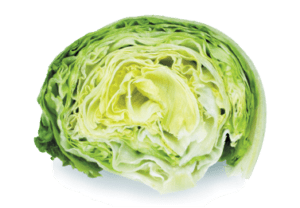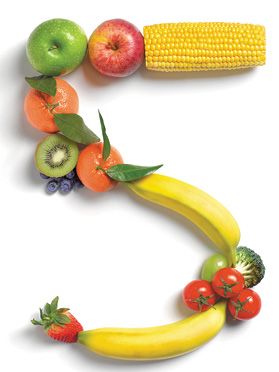Getting enough Fruits and Veggies . . . Iceberg vs. Romaine
Q. I want to eat five cups of fruits and vegetables a day, but I have trouble eating a whole cup at one sitting. What can I do? Are those fruit and vegetable pills I see advertised a good solution?
A. Alice H. Lichtenstein, DSc, Stanley N. Gershoff Professor of Nutrition Science and Policy at the Friedman School and executive editor of Tufts Health & Nutrition Letter, answers: “This is really three questions in one! First, the quantity of fruits and vegetables you need to eat depends on your age, sex, height, weight, and level of physical activity. Although often repeated, the general advice to consume five servings of fruits and vegetables a day is not a scientific recommendation. It is recommended that most adults consume two-and-a-half to four cup-equivalents of vegetables and one-and-a-half to two cup-equivalents of fruit a day. A ‘cup-equivalent’ of vegetables is, in general, one cup of raw or cooked vegetables or vegetable juice, or two cups of raw leafy salad greens. One cup of fruit or 100% fruit juice, or one-half cup of dried fruit can be considered as a cup-equivalent of fruit. A small apple, a medium grapefruit, and a large banana are other examples of “cup-equivalents” of fruit.
It is likely you actually do eat the equivalent of a whole cup of fruits or vegetables at one sitting. Small portions of different foods add up, so the serving can be made up of more than one type. For example, you may slice half a banana on your morning cereal and have a small glass of orange juice—that’s one serving total. A green salad for lunch is likely one-and-a-half or two servings, but lettuce and tomato on a sandwich along with a handful of baby carrots or red pepper slices and a crisp apple is also two. Dinner might start with a salad or a cup of vegetable soup. Add chopped veggies to casseroles, stir-fries, and pasta dishes, or spoon a generous topping of prepared salsa or diced mango, tomato, and red onion over your fish or chicken and add a half a cup of a vegetable on the side and you’re right around five servings.
Products that claim to pack all the nutrition of fruits and vegetables into a little pill are too good to be true. They lack the hydrating water, most of the fiber, and many of the other compounds naturally present in food. It is unclear whether all the other nutrients are retained after the processing necessary to make the pills. Additionally, if you aren’t eating a diet rich in fruits and vegetables, you are likely eating less desirable foods, such as those that are highly processed, made with refined sugars and starches, and high in salt. There is no evidence that you can substitute these pills for the real thing.
Q: I’ve heard that romaine lettuce is more nutritious than iceberg

Iceberg lettuce has nutritional value, although darker greens have a bit more. The same can be said for pink versus red salmon, although for different reasons.
because it is darker in color. Does the same hold true for red versus pink canned salmon?
A: Judith C. Thalheimer, RD, LDN, managing editor of Tufts Health & Nutrition Letter, answers: “Dark leafy greens do have more of some nutrients and phytochemicals than lighter greens like iceberg lettuce, but most lettuce greens are at least 95 percent water, so none of them provide a huge dose of nutrients. Nevertheless, they are all healthy choices. Iceberg has a satisfying crunch and mild taste that appeals to individuals who find other types of leafy greens bitter. It provides fluid, fiber, and small amounts of folate, vitamins A and K, and potassium, among other nutrients, with very few calories (10 per cup of shredded lettuce). If you are concerned about your nutrient intake, consider mixing iceberg lettuce with romaine, arugula, spring greens, or, better yet, spinach or kale, which are more nutrient-dense.
“Leafy greens get their color from chlorophyll, a pigment used to absorb energy from the sun. Salmon gets its color from its diet. Wild salmon get a reddish-orange compound called astaxanthin from eating krill and shrimp. (Farmed salmon are often fed astaxanthin supplements so consumers get a familiar-colored fish.) That said, pink and red canned salmon are actually two different species, both typically caught in the Pacific Ocean. Humpback salmon are pink, and sockeye salmon are darker in color. Sockeye (red) salmon (which is generally more expensive and has a stronger flavor and denser texture) is a bit richer in heart-healthy omega-3 fatty acids, but both species are good choices. Canned salmon is convenient, versatile, tasty, and nutritious, no matter what color you choose.”
























